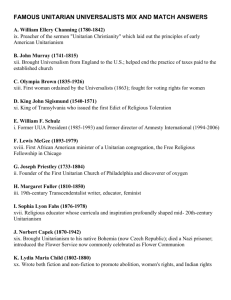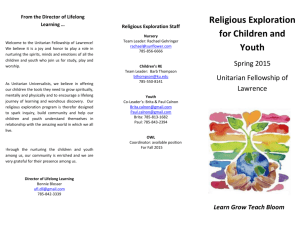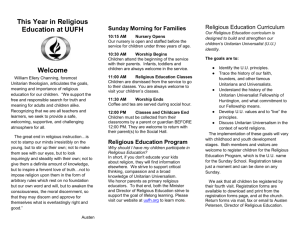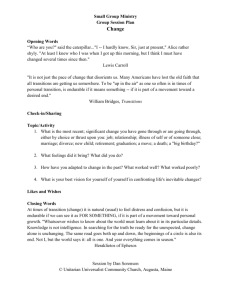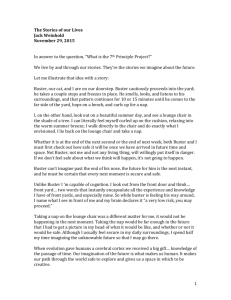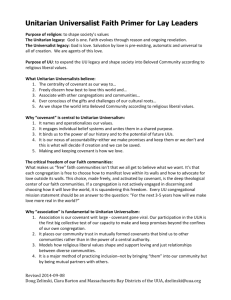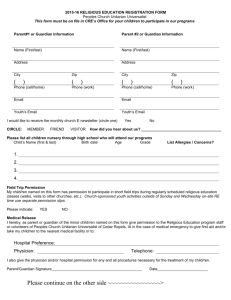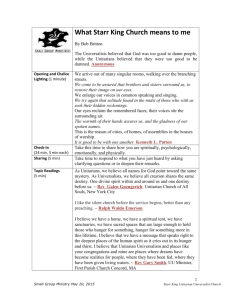Entire Workshop
advertisement
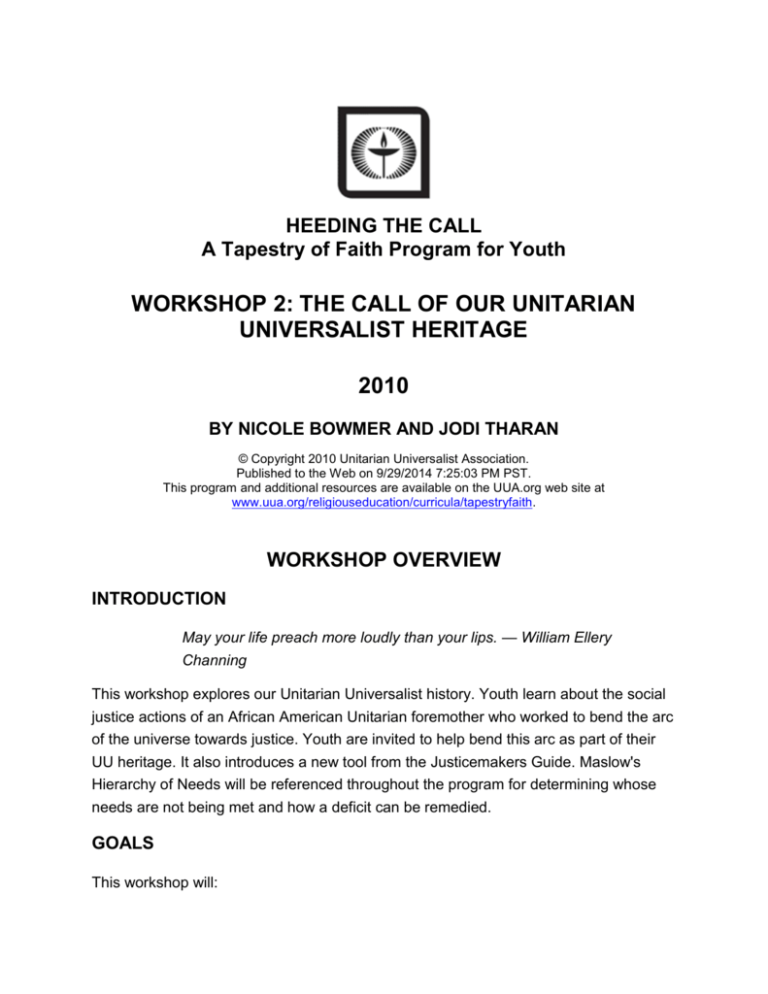
HEEDING THE CALL A Tapestry of Faith Program for Youth WORKSHOP 2: THE CALL OF OUR UNITARIAN UNIVERSALIST HERITAGE 2010 BY NICOLE BOWMER AND JODI THARAN © Copyright 2010 Unitarian Universalist Association. Published to the Web on 9/29/2014 7:25:03 PM PST. This program and additional resources are available on the UUA.org web site at www.uua.org/religiouseducation/curricula/tapestryfaith. WORKSHOP OVERVIEW INTRODUCTION May your life preach more loudly than your lips. — William Ellery Channing This workshop explores our Unitarian Universalist history. Youth learn about the social justice actions of an African American Unitarian foremother who worked to bend the arc of the universe towards justice. Youth are invited to help bend this arc as part of their UU heritage. It also introduces a new tool from the Justicemakers Guide. Maslow's Hierarchy of Needs will be referenced throughout the program for determining whose needs are not being met and how a deficit can be remedied. GOALS This workshop will: Identify our Unitarian Universalist heritage as helping to bring about a more just world Illustrate the social justice actions of Unitarian Universalists Point youth to the social justice work in their congregation Provide another justice-making tool. LEARNING OBJECTIVES Participants will: Identify their UU heritage as bringing about a more just world Connect to a history of UU social justice work Explore justice-making in their congregation Explore Maslow's Hierarchy of Basic Needs and understand how meeting basic needs is a justice issue. WORKSHOP-AT-A-GLANCE Activity Minutes Opening 5 Activity 1: Basic Needs 15 Activity 2: Story — Frances Harper Bends the Arc 10 Activity 3:Justice Treasure Hunt 25 Faith in Action: Carrying On the Legacy Closing 5 Alternate Activity 1: UU Justice Art 30 SPIRITUAL PREPARATION Reflect on your memories of Unitarian Universalism. Pay attention to any images that come to mind. What brought you into your current relationship with this liberal faith? If you were born into Unitarian Universalism, did you intentionally embrace a Unitarian Universalist identity as an adult, or is it simply who you have always been? If you came to Unitarian Universalism on your own later in life, which experiences of this journey are the most vivid? WORKSHOP PLAN OPENING (5 MINUTES) Materials for Activity Chalice, candle, lighter or LED/battery-operated candle Newsprint, markers and tape Preparation for Activity Write the chalice lighting words on newsprint and post. Description of Activity Gather youth in a circle. Welcome first-time participants. Ask youth to go around the circle and say their names. Ask if anyone would like to share anything from their Justicemakers Guide since the last meeting. Light the chalice, or invite a participant to do so, and recruit a volunteer to read the chalice lighting words: As we light this chalice, we take a moment to reflect on the people who have walked the path of justice before us, beside us, and we hope will join us on this path of deep caring. Ask the group to be silent for a moment as they reflect on the words. End the silence with "So be it," or other appropriate words. Tell the group that today's theme is our Unitarian Universalist heritage. Ask for volunteers to share what they think our faith heritage has to do with justice. ACTIVITY 1: BASIC NEEDS (15 MINUTES) Materials for Activity Handout 1, Maslow's Hierarchy of Needs (included in this document) Preparation for Activity Create a workshop copy of this tool by taping one copy of Handout 1 to poster board for display throughout the program. Description of Activity Youth define basic human needs. Dictionary.com defines social justice as the "distribution of advantages and disadvantages within society." Nowhere are the disadvantages more evident than when it comes to fulfilling basic needs. Ask participants if they agree that justice includes making sure everyone is able to fulfill their basic needs. If they agree, ask, "What are the basic human needs? Air, food, and water? What about shelter? What about security? What about love and/or companionship—is that a basic need? Ask, "Who defines the basic needs?" Distribute Handout 1, Maslow's Hierarchy of Needs. Abraham Maslow was a psychologist who, in A Theory of Human Motivation (1943), proposed a theory to explain human needs. Review the handout, opening the floor to agreements, disagreements, and questions. Ask if there are any words on the diagram that are unfamiliar to youth. Tell them that the pyramid representing human needs is part of the Justicemakers Guide. The needs at the bottom of the pyramid are the most basic. Maslow's theory is that an individual cannot concern themselves about meeting the needs in the upper portions (such as self-actualizing needs) until the basic needs at the bottom are met. Yet, "poverty" or feelings of oppression can result when any of these needs, no matter where they are ranked, are not being met. When people cannot meet basic needs, they exhibit anxiety and distress. This could lead to depression. It could lead to anger. It could lead to violence. It could also lead to social action. Maslow's theory is just one theory. Some people agree with the needs Maslow identified, yet do not believe they are hierarchal. Other theories propose a different set of needs and others argue that needs are culturally based and therefore the same set of needs may not apply to all humans. Participants need not embrace this theory. However, being aware of our needs and the needs of others—particularly the less obvious needs—is crucial to the work of justice making. For example, even if gay couples may feel less physically threatened in public in some areas, the inability to cover loved ones under family health insurance policies could leave a couple physically vulnerable and unsafe because of prohibitively expensive health insurance. What other examples can youth add? Remind youth that as we work together with communities in need of justice, we want to always ask the community what their needs are and not assume we know what is lacking or needed the most. For example, a youth group working to help rebuild after Hurricane Katrina approached community leaders to ask what help was needed. They thought they might be asked to build new houses. Instead, they were asked to paint the fence surrounding the schoolyard. It was not that the community did not need houses, but that what the community needed more was to send their children to a school they feel good about and to have beauty return to their lives. If participants are keeping paper copies of the Justicemakers Guide, add Handout 1 as a page. If keeping the guide electronically, let them know how to access Handout 1 to add to their CD or hard drive. ACTIVITY 2: STORY — FRANCES HARPER BENDS THE ARC (10 MINUTES) Materials for Activity Copy of the story "Frances Harper Bends the Arc (included in this document) " Leader Resource 1, Frances Harper Photo (included in this document) Optional: Computer with Internet access Preparation for Activity Read the story until you are comfortable presenting it. Optional: Make copies of the story for youth to share and read along. Optional: If you do not have a computer with Internet access available, print out information from the Unitarian Universalist Association's Social Justice website (at www.uua.org/socialjustice/index.shtml) to share with the group. Description of Activity Youth hear and discuss a story about a woman attracted to our faith because of Unitarianism's reputation for social justice work. Print out Leader Resource 1, Frances Harper Photo, and show the photo to the group. Ask youth, "Why are we discussing social justice at church?" Take responses. If no one ties justice work into the first Principle, do so yourself. Refer to Maslow's hierarchy and remind participants that a starting point for justice work is making sure people have equal access to the resources needed to satisfy their basic needs. We believe that enabling everyone to have equal access upholds the inherent worth and dignity of all people and that we support this principle not just in talk but also in action. Ask if the group agrees that working toward a just society is one way we put our UU faith in action. Tell participants you have a story to share about UUs putting their faith in action. Tell or read the story. Here are questions to spark a discussion after the story: The story suggests that Harper was attracted to the Unitarian church because of its stance on justice issues that concerned her. Do you think this is a strong reason to join a church? Do you think there are people in UU congregations today for the same reason? How does that make you feel about your religion? Why do you think Harper kept her membership at the AME church? Do you know any members of your congregation who have memberships at other congregations, churches, or temples? Have you belonged to or attended a church besides a UU congregation? What justice activities did that congregation offer? What were some of the justice issues in Harper's day? Are those still issues today? Are there related justice issues today? What are some of the justice issues UUs are involved in today? (If youth do not know and your room has Internet access, let the group view the Unitarian Universalist's Social Justice (at www.uua.org/socialjustice/index.shtml) website for answers. If this is not feasible, share the pages from the website you printed out from Preparation for Activity.) Say, in your own words: This commitment to help bring about justice in the world is our UU heritage and value. Harper met Unitarians while working for justice. She joined with them to increase the call for equality for African Americans and women and the call was stronger because of it. Through the centuries, UUs have joined with like-minded people in the call for justice. The same is true today and, I hope, will be true tomorrow. Tomorrow depends upon you. I hope that you, our present and future justice makers, will heed the call. ACTIVITY 3: JUSTICE TREASURE HUNT (25 MINUTES) Materials for Activity Index cards and pencils Baskets or bags (1 per pair of youth) to collect treasures Description of Activity Youth will explore the congregation for signs of justice making. Ask participants if they think their congregation is actively involved in justice making right now. This activity invites youth to look for clues as to how the congregation puts Unitarian Universalist faith into action. Divide the group into pairs. Each pair will go on a treasure hunt for ten minutes to find at least five items that represent how the congregation is involved in justice making. Remind youth to be respectful and to collect only items that cannot be harmed or will not disturb anyone in the process. If they wish to include an item that cannot be put in the basket, instruct them to use the index card and pencil to write it or draw it. Make suggestions and urge them to think broadly. For example, collecting recycling goods means less space for landfills, which typically are located in poorer neighborhoods and contribute to environmental racism or classism. Tell the participants that they will need to describe why they chose the items when they return to the whole group. Once the group has returned and shared, ask the following questions: Did you find evidence that social justice is important to the congregation? Was it difficult to find signs of justice making? Did you discover an activity the congregation is involved in that you did not know about? Did you find any activities you are or were a part of? Which ones? Did you find any activities the congregation participates in with others from different faiths? Are UUs the only people who believe we have a responsibility to work for justice? Were any of the activities ones UUs might have participated in 10 years ago? What about 50? What about 100? Remind the group that times change and so do the issues, and since the world is not perfect, there are always places where injustice exists. Therefore, we, as UUs must work with other people of faith to become aware of injustice and speak truth to power. CLOSING (5 MINUTES) Materials for Activity Copies of Taking It Home for all participants Description of Activity Thank first-time guests for their contributions to the group. Gather youth in a circle and remind the group that they walk on religious ground that was cared for by those who went before them. Invite volunteers to say the name of one Unitarian Universalist, perhaps from today's workshop or someone in the congregation, who they admire and what about that person's life the youth will strive to make a part of their own life. Once everyone has shared, thank them for caring for this ground that they, too, are passing along to future Unitarian Universalists. End the workshop with these words: May we leave here ready to remember and honor those who walked the road to justice before us. Let us walk forward with these people's actions guiding our steps. FAITH IN ACTION: CARRYING ON THE LEGACY Materials for Activity Assorted materials from youth's community service or justice projects Permission slips Optional: Video camera or notepads and pens Preparation for Activity Decide as a group how you will structure the event and what you will do with the children's reflections. Make arrangements as needed. If you are going to share the children's reflections, get signed permissions from children and caregivers/parents. Description of Activity Participants interview future justice makers. Many youth are already involved in helping create justice. Younger children may not have had as many opportunities to do so. Encourage the group to help grow future justice makers by inviting younger children in the religious education program to share justice work experiences. One way this could happen is through an event hosted by participants. The event could include a presentation by youth of projects they are or have been involved with that furthered justice. The presentation could include video and other media. At the end of the presentation, invite the children to talk about the issues that they envision themselves supporting in the future. Heeding the Call participants could videotape children as they talk about future justice work and produce a short DVD to show at a congregational gathering or as part of a worship service. Children might already have experience in community service and justice work and these experiences could be talked about, too. If videotaping is difficult, youth can take notes and write an article for the newsletter or share quotes during a congregational gathering or worship service. Do not forget to get permission from the children and their parents or legal guardians for filming them. LEADER REFLECTION AND PLANNING As religious educators working with youth in a Unitarian Universalist context, this workshop offered an opportunity to focus on Unitarian Universalists who have come before us. What was it like to help youth connect with Unitarian Universalist heritage? So often young people are looking forward but it is critical that they are also grounded in the teachings of the past. Did your connection to Unitarian Universalist heritage increase from facilitating this workshop? What did you as co-leaders learn from the youth? TAKING IT HOME May your life preach more loudly than your lips. — William Ellery Channing In Today's Workshop... We talked about the moral arc of the universe bending toward justice with our help and the help of those who came before us. Some of those were our Unitarian Universalist ancestors. We heard a story about an African American Unitarian ancestor who bent the arc toward greater freedom for blacks and women. We looked for evidence of justice work in our congregation. We learned about Maslow's Hierarchy of Basic Needs and how justice means trying to help everyone get access to resources to meet those needs. Our Unitarian Universalist Heritage Aside from your commitment to being a justice maker, how else does your life reflect your UU heritage? Do you have a chalice at home? Does your family say grace at meals or prayers at night? Do you own chalice jewelry? Do you sing UU hymns at home? Were your parents or caregivers raised UU? If so, ask them what keeps them connected to this religion. If not, ask them what attracted them to this religion. Read more about Frances Harper, John Adams, Christopher Reeves, Susan B. Anthony, Rachel Carson, and Theodore Parker. Check out books from the library or visit these websites: Dictionary of Unitarian and Universalist Biography (at www25.uua.org/uuhs/duub/index.html), Famous UUs (at www.famousuus.com/), and UU Women's Heritage Society (at www.uuwhs.org/). Find out what others say about Unitarian Universalism by visiting the YouTube Unitarian Universalist channel. (at www.youtube.com/results?search_query=unitarian+universalist&search_type=& aq=2&oq=unitar) Explore other heritages that you share with your family. Discuss those ethnic, cultural, and recreational heritages. Celebrate those by creating a special meal using family recipes or renting a foreign film (with subtitles) from a country of origin. Did your grandparents grow up playing cricket or soccer or bowling? Have a family tournament! Maslow's Hierarchy of Basic Needs Ask your friends about their basic needs. Do their needs fit neatly into Maslow's chart or do you need to add levels? Maslow's Hierarchy of Needs is a very popular psychological tool; there are YouTube videos illustrating the pyramid, such as this one (at www.youtube.com/watch?v=JTP4954uMho&feature=related), in a humorous way. Take this quick self-test from Business Balls to find (at www.businessballs.com/maslow5quicktest.pdf) out how your basic needs are being met. Justicemakers Guide Remember to use the guide to note experiences you have this week with justice or injustice. What did you see? Were you able to help? If not this time, will you be able to help in the future? How will you enable yourself to be ready to help in the future? Do you need the help of others? If you are keeping the Justicemakers Guide electronically, remember to add Maslow's Hierarchy of Needs to your copy. As you hear or read about injustice, refer back to the tools in your guide. Ask, "Who's basic needs are not being met?" Ask whether you have the same needs and how that need is being met. Is it possible to help others meet their needs in the same way? Add your thoughts to the guide. ALTERNATE ACTIVITY 1: UU JUSTICE ART (30 MINUTES) Materials for Activity Newsprint, markers and tape Various art materials Optional: Justicemakers Guide, if using Option 1 Description of Activity Youth express their justice commitments through art. Brainstorm a list of social justice causes that concern youth. These might include BGLTQ rights, comprehensive sexuality education, immigration justice, ending racism, full equality for women, religious tolerance, and other issues. After ideas stop flowing, invite youth to create a work of art that demonstrates their commitment to these issues. It can focus on just one or many issues. Their artwork should address: What role will youth play in addressing these wrongs? Who will do this work with them? What will the world look like when justice is won? Let participants work for 20 minutes, then gather everyone and invite volunteers to share their work. Discuss any similarities and differences in the artwork. Is their faith represented in some way in the art? Why or why not? Do they think they could find like- minded people in the congregation who feel strongly about these issues and who would work alongside them? Invite them to do just that. The names of these individuals can be added to their Justicemakers Guide. HEEDING THE CALL: WORKSHOP 2: STORY: FRANCES HARPER BENDS THE ARC By Jessica York. Sometimes, freedom is a long time coming. It may take generations upon generations for justice to be won. Our Unitarian ancestor Reverend Theodore Parker said, "I do not pretend to understand the moral universe: the arc is a long one... from what I see I am sure it bends towards justice." The Reverend Martin Luther King, Jr, often used this quote. Barack Obama, 44th and first African American president of the United States added,"... but here is the thing: it does not bend on its own. It bends because each of us in our own ways put our hand on that arc and we bend it in the direction of justice...." The hands of Unitarian Universalist have been bending the arc for many years. You may have heard of John Adams, Susan B. Anthony, Christopher Reeve, or Rachel Carson. Have you heard of Frances Ellen Watkins Harper? Her hand was on the arc, too. Harper was born a free black woman in Baltimore, Maryland in 1825. She was raised in the household of her uncle, an educator and African Methodist Episcopal (AME) minister. He was also an abolitionist—a person who objected to the enslavement of blacks. Harper followed in her uncle's footsteps to become an educator and abolitionist. She also became a writer, publishing her first book of poetry at twenty and publishing the first short story by an African American woman later in life. Her writing often urged blacks, women, and people in oppressed groups to take a firm stand for equality. In 1850, the Fugitive Slave Act was passed. It became dangerous to be a free black in Maryland because slave owners could claim black people were runaway slaves and force them into slavery. So, Harper moved farther north to Ohio and then to Philadelphia. She taught, ran part of the Underground Railroad, and lectured around the country to bend the arc toward justice for African Americans. In 1863, abolitionists celebrated success with the passage of the Emancipation Proclamation. It did not immediately create a world where African Americans were treated equally and fairly, but it did make slavery illegal. Harper saw that there was still work to be done. She put her hand toward women's civil rights, in particular the rights of black women and the right of all women to vote. She cofounded the National Association of Colored Women. Again, she toured and lectured on the topic of freedom. Her lectures and writings spoke to the need for women to be free to be more than wives and mothers. She understood what she was talking about: a mother herself, after her husband died Frances Harper took her daughter with her on her lecture tours. During her justice work, Harper met many Unitarians also working to bend the arc. She felt at home with our liberal religious beliefs and knew that her work could strengthen the justice work of the Unitarians. She joined hands with them by joining the First Unitarian Church in Philadelphia in 1870. She frequently read her poetry from the pulpit at this church, yet she kept her membership and taught Sunday school at an AME church, too. Harper died in 1911, before the 19th Amendment gave women the right to vote in 1919. This was a cause she worked hard to bring about. Yet, Harper understood that her labors might bring about freedoms she would never enjoy. She said, "Apparent failure may hold in its rough shell the germs of a success that will blossom in time, and bear fruit throughout eternity." Some of the fruits of Harper's labor—and the labor of other Unitarian Universalists—are enjoyed by us today. Yet, we are not done. Oppression still exists in our world. Harper's hands—and Parker's, Adam's, Anthony's, Reeve's and Carson's—are no longer on the arc. Our hands are needed to take their place. May the bending continue until victory is won. HEEDING THE CALL: WORKSHOP 2: HANDOUT 1: MASLOW'S HIERARCHY OF NEEDS Based on the work of psychologist Abraham Maslow. Download a high-resolution PDF (at www.uua.org/documents/tapestry/htc/maslow_hierarchy.pdf) for printing. HEEDING THE CALL: WORKSHOP 2: LEADER RESOURCE 1: FRANCES HARPER PHOTO FIND OUT MORE Unitarian Universalism This Day in Unitarian Universalist History, by Frank Shulman (Boston: Skinner House, 2004) is packed with UU history. Another classic in UU history is Unitarian Universalism: A Narrative History, by David E. Bumbaugh (Chicago: Meadville Lombard Press, 2001). Frances Watkins Harper Many of Harper's work are available. For starters, read the Collected Works of Frances Ellen Watkins Harper (Charleston: BiblioBazaar, 2007) or see what your library may hold. There are also a few biographies of Harper. One is Discarded Legacy: Politics and Poetics in the Life of Frances E.W. Harper, 1825-1911 (Detroit: Wayne State University Press, 1994) Maslow Read more about Maslow's theory of human motivation at Classics in the History of Psychology (at psychclassics.yorku.ca/Maslow/motivation.htm).
